ikfoundation.org
The IK Foundation
Promoting Natural & Cultural History
Since 1988


 Crowdfunding Campaign
Crowdfunding Campaignkeep knowledge open, connected, and growing on this textile history resource...
FORGOTTEN TEXTILE OBSERVATIONS
– from the year 1840 in England
Follow the young Swedish traveller, J P Bager, as he walks through the streets of København and Hamburg en route to London – the home of more than a million people and the greatest centre of trade in the world. He also visited Birmingham, Manchester, Liverpool, Leeds and Hull during his journey in the late summer of 1840. The Victorian Age was in its infancy and the well-oiled machinery of England’s prospering industries brought a new era of finance and trade to the expanding empire. Textile observations were also present in his travel journal; for example, one can read about how his accommodation in a private home was furnished, the fashion traders in central London, his glimpse of Queen Victoria, the Polytechnic Institute on Regent Street, cotton spinning mills in Manchester and the Cloth Hall in Leeds. The aims of this essay are to introduce Bager’s unique account and give a couple of quotes from a textile point of view.
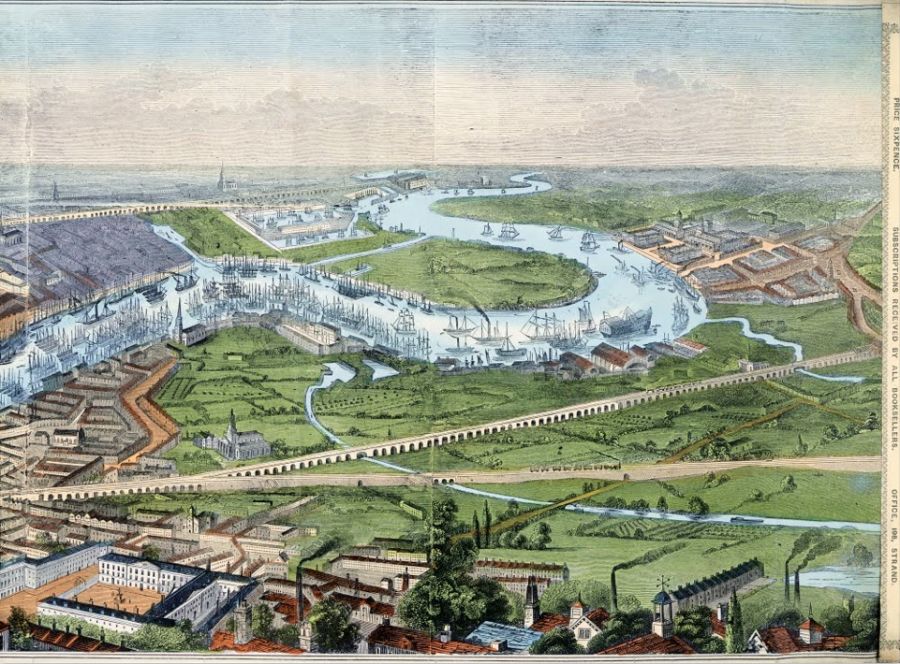 Panorama of London and the River Thames 1845-50. Coloured engraving, Illustrated London News. (Courtesy of: Museum of London, Google Art Project).
Panorama of London and the River Thames 1845-50. Coloured engraving, Illustrated London News. (Courtesy of: Museum of London, Google Art Project).Johan Peter Bager (1818-1888) was born in Malmö, which was then a small city on the edge of northern Europe. He was the son of a privileged family of merchants, when he was between the ages of five and thirteen, his family could afford to send him to the Moravian United Brethren school in Kristiansfeld, Denmark. An education that was to leave its mark in the form of a philosophy that was firmly fixed in the preachings of liberalism. Bager’s travels – at the age of 22 – through Europe, on the threshold of dramatic change, showed him the power and opportunities of industrialism and thereby introduced him to the vision of capitalism. Despite the enthusiasm of youth, Bager also reflected on the potential negative aspects to both the environment and mankind.
On his return to Sweden, he became deeply involved in local and national politics and worked hard to promote the building of a new infrastructure based on shipping and rail transport. On his earlier travels, he left a country that was vacillating between cottage industries and farming on the one hand, and industrialism on the other. From here, he travelled to Europe, more particularly England, where speed, innovation and a new approach were the order of the day.
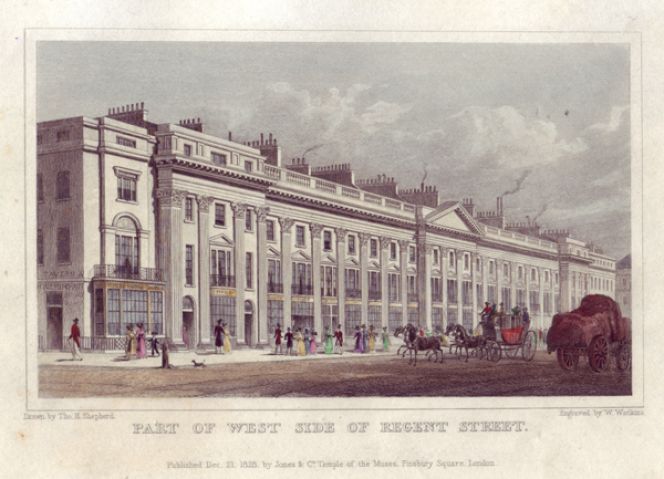 This street view of the west side of Regent Street shows a somewhat earlier depiction of the possibilities for shopping and the wide pavements – observed by Bager – which as well made it possible for prospective lady customers to comfortably walk up and down the street without soiling their delicate dresses. (Illustration by Thomas Shepherd, engraved by W. Watkins in 1828).
This street view of the west side of Regent Street shows a somewhat earlier depiction of the possibilities for shopping and the wide pavements – observed by Bager – which as well made it possible for prospective lady customers to comfortably walk up and down the street without soiling their delicate dresses. (Illustration by Thomas Shepherd, engraved by W. Watkins in 1828).Already during his second day in London (29th August), he noticed the busy central streets; ‘A Considerable obstacle for making headway on the streets is, more than the swarming crowds of people, through which one quickly learns to negotiate on the excellent wide pavements, the seductively inviting and constantly beautiful and tastefully varied boutiques… In these windows one can see either a lady or a proud man, made of wax, dressed in the most fashionable clothes, hats, millinery and other adornments so several people can inspect from all sides as they slowly wander around. The owners of houses with such exhibitions are mostly perfumery or fashion traders… But how would it be possible to count all these unusual curiosities that are displayed in the countless London boutiques that, in multifarious ways, attract the attention and interests of strangers and tempt them to buy, and with constantly changing ingenuity for speculation and capricious fashion, they bring forth new items.’
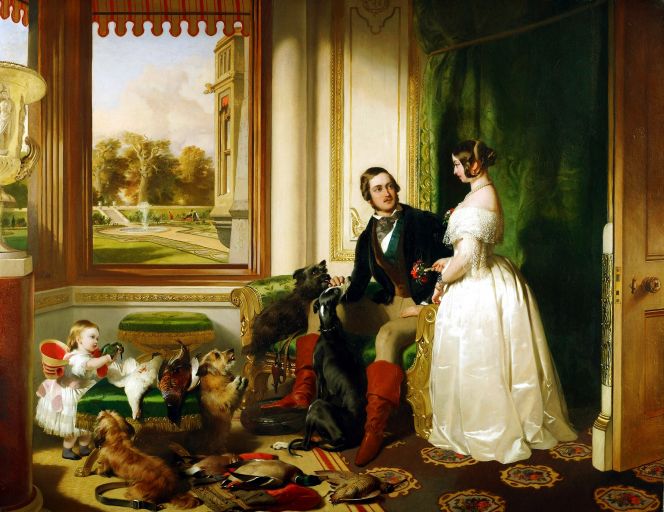 On the 1st of September J P Bager visited Windsor Castle on a guided tour, admired the park, strolled in Windsor and Eton, before he left for London he also got a glance of the Queen and Prince Albert in their carriage. He noted; ‘…The Queen, whose youthful features and fine appearance were easily recognisable and were very like previously seen and slightly flattering portraits… Prince Albert, who has the advantage of being handsome in a manly way, waved back to the crowd and in so doing raised his hat…’. Bager’s observations can be compared with the contemporary oil on canvas “Windsor Castle in Modern Times” by Edwin Henry Landseer 1840-43 showing Queen Victoria and Prince Albert at Windsor Castle. (Courtesy of: Wikimedia Commons).
On the 1st of September J P Bager visited Windsor Castle on a guided tour, admired the park, strolled in Windsor and Eton, before he left for London he also got a glance of the Queen and Prince Albert in their carriage. He noted; ‘…The Queen, whose youthful features and fine appearance were easily recognisable and were very like previously seen and slightly flattering portraits… Prince Albert, who has the advantage of being handsome in a manly way, waved back to the crowd and in so doing raised his hat…’. Bager’s observations can be compared with the contemporary oil on canvas “Windsor Castle in Modern Times” by Edwin Henry Landseer 1840-43 showing Queen Victoria and Prince Albert at Windsor Castle. (Courtesy of: Wikimedia Commons).A couple of days later (5th September) which he dedicated to studying the industry and prospering innovations, ‘…in the splendour of Regent Street, the Polytechnic Institute; where I would liked to have arrived earlier and spent a whole day. Indeed, one could easily spend a few days with great interest… Having passed through a large hall, in which I saw how material is woven from glass and silk: how ribbons and lace are woven by machines without the help of the human hand…’ Bager seemed to be overwhelmed with all new impressions and after several pages of detailed descriptions he concluded with; ‘Observers of the development of life in Europe, reflect upon the constant and gigantic steps of the English. Not only with respect to new discoveries and improvements but also their genius for exploiting them in business and to the advantage of the nation, its standing and wealth. Their nationalistic fervour for the prosperity of science and art and the dissemination of general knowledge. At six o’clock, it was announced that the doors were closing.’
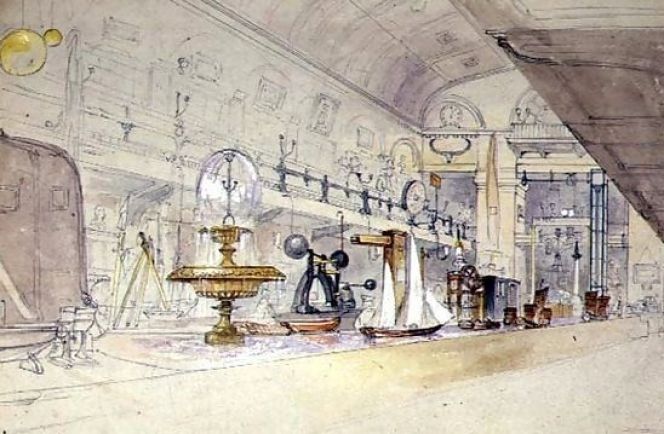 Interior of the Polytechnic Institute, Regent Street, London, drawn by G.F. Sargeant and published in 1847. The institute was visited by Bager in early September 1840, only two years after its opening. (Courtesy of: Wikimedia Commons).
Interior of the Polytechnic Institute, Regent Street, London, drawn by G.F. Sargeant and published in 1847. The institute was visited by Bager in early September 1840, only two years after its opening. (Courtesy of: Wikimedia Commons).Another observation, which includes textiles; takes us to Manchester (15 September), where Bager had arranged to visit one of the largest cotton spinning mills in the area. His journal reads; ‘No fewer than 1,400 people are employed here and in 16 great workshops a large number of spinning machines are employed, and the wonderful mechanical devices seem to make the employment of human labour almost unnecessary. One single spinning machine now performs work that was formerly done by hand by one to two hundred people, and it is run by only one person… In the printing works of Messrs Heald Wilson & Co, it was interesting to see the precision of the printing. The material is sent from the upper floor and runs through a number of rollers, each of which prints a particular colour and façonné, and when it leaves the last pair of rollers, it appears ready printed.’
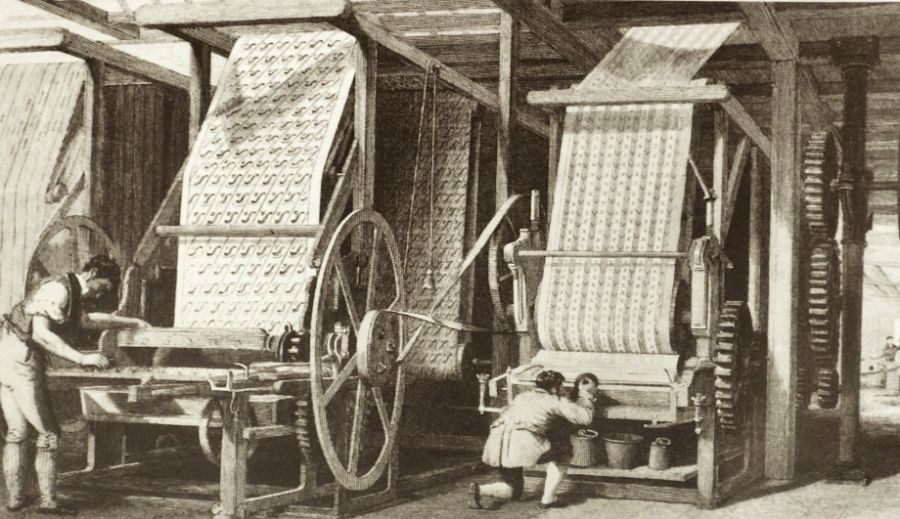 This plate originating from Edward Baines History of the Cotton Manufacturers in Great Britain (1835) illustrates well what J P Bager observed at the calico printers in Manchester in 1840. However it can be reflected that both Baines’ illustration and Bager’s journal text left out the dirt and unhealthy working conditions in the textile industry.
This plate originating from Edward Baines History of the Cotton Manufacturers in Great Britain (1835) illustrates well what J P Bager observed at the calico printers in Manchester in 1840. However it can be reflected that both Baines’ illustration and Bager’s journal text left out the dirt and unhealthy working conditions in the textile industry.There is much more to explore in the book Impressions of London from the Late Summer of 1840 – covering the complete account of his journey – describing clothing, social history, trade, industry, travelling, etc. The book is both an enjoyable travel account to read and a relatively unknown primary source from the very early Victorian era.
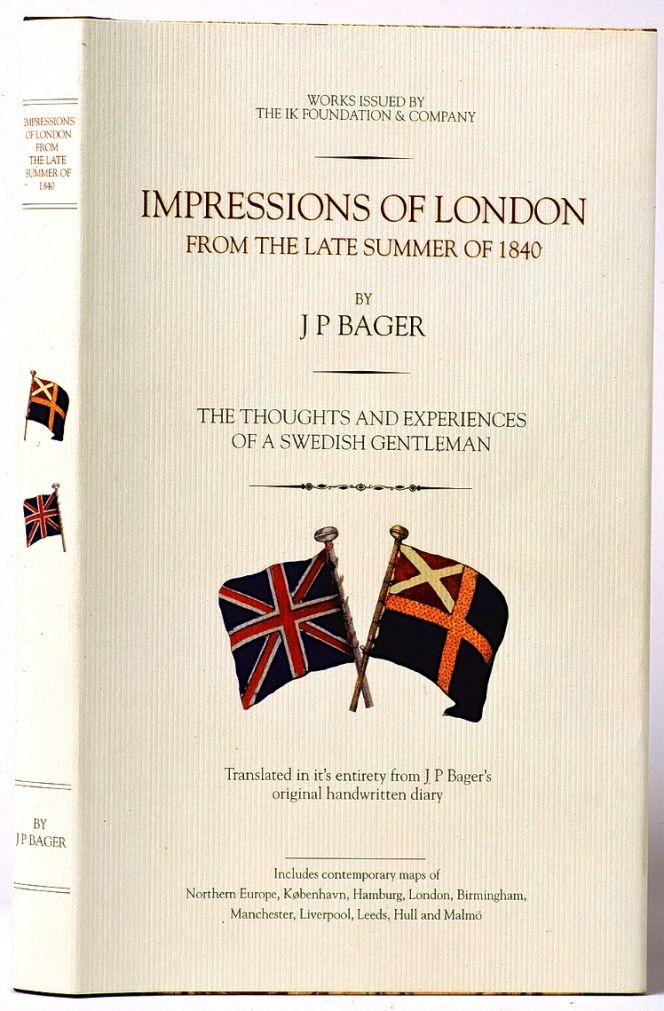 Johan Peter Bager’s original travel account was published in English 2001 as a full written copy of the his notes ‘Impressions of London from the Late Summer of 1840'.
Johan Peter Bager’s original travel account was published in English 2001 as a full written copy of the his notes ‘Impressions of London from the Late Summer of 1840'.Source:
- Bager, J P, Impressions of London from the Late Summer of 1840, London & Whitby 2001.
Essays
The iTEXTILIS is a division of The IK Workshop Society – a global and unique forum for all those interested in Natural & Cultural History.
Open Access Essays by Textile Historian Viveka Hansen
Textile historian Viveka Hansen offers a collection of open-access essays, published under Creative Commons licenses and freely available to all. These essays weave together her latest research, previously published monographs, and earlier projects dating back to the late 1980s. Some essays include rare archival material — originally published in other languages — now translated into English for the first time. These texts reveal little-known aspects of textile history, previously accessible mainly to audiences in Northern Europe. Hansen’s work spans a rich range of topics: the global textile trade, material culture, cloth manufacturing, fashion history, natural dyeing techniques, and the fascinating world of early travelling naturalists — notably the “Linnaean network” — all examined through a global historical lens.
Help secure the future of open access at iTEXTILIS essays! Your donation will keep knowledge open, connected, and growing on this textile history resource.
been copied to your clipboard




– a truly European organisation since 1988
Legal issues | Forget me | and much more...
You are welcome to use the information and knowledge from
The IK Workshop Society, as long as you follow a few simple rules.
LEARN MORE & I AGREE







